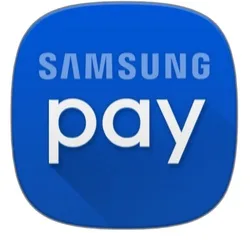Compare other products
We currently don't have that product, but here are others to consider:
How we picked theseSamsung Pay is an app that allows you to make tap-and-go payments from your Samsung phone or compatible device. It is supported by many Australian banks and credit card providers – including American Express, ANZ, Citi, CommBank, NAB and Westpac.

How does Samsung Pay work?
Samsung Pay uses NFC (Near Field Communication) and MST (Magnetic Secure Transaction) technology, which is embedded in Samsung devices. The bottom line: this tech allows you to make payments at the checkout.
Instead of tapping your credit card against the payment machine, you just swipe up on your smartphone screen, authenticate the transaction using your preferred method (iris, fingerprint or PIN), and tap your phone against the contactless terminal.
The phone must be within 3cm of the terminal to complete the payment.
Which devices are compatible with Samsung Pay?
The app is available from the Samsung Galaxy S6 onwards, which all have the integrated NFC chip and a magnetic coil built into them. This includes the Galaxy S6, S6 Edge+, Note 5, Galaxy S7 and Galaxy S7 Edge.
Samsung Pay is also compatible with some non-Samsung phones and smartwatches that have Android 6.0 or higher.
Check Samsung's full device eligibility list.
How to install Samsung Pay
- On the Home screen, select Apps.
- Touch Samsung Pay.
- Select INSTALL to download the file.
- If there are updates to the built-in application, touch INSTALL.
- Touch OPEN to start using Samsung Pay.
How to add your card to your Samsung Pay app
- Install and then open the Samsung Pay app (you may have to sign in to your Samsung Account) and tap start.
- Choose a verification method (iris, fingerprint or PIN).
- Tap "Add card".
- You can scan your card via your phone's camera or enter the card details (card number, expiry date) manually.
- Enter your billing address.
- Verify your card with a code sent to you via SMS or email. You may be prompted to add a signature as well.
- Then you're good to go.
Full list of Australian banks that support Samsung Pay
Is Samsung Pay safe to use?
Samsung Pay was designed to be just as safe, if not safer, than regular contactless card payments. Samsung Pay uses Tokenisation, a Secure Environment and Samsung KNOX to keep your payment information safe. What does this mean?
- Tokenisation. None of your personal bank information is stored on your Samsung device or the Samsung service. Instead, Samsung Pay uses Tokenisation to replace your sensitive payment information (such as the card number, expiration date, security code etc) with a device-specific token which acts as a stand-in value.
- Secure Environment. A Secure Environment, sometimes referred to as a Trusted Execution Environment, refers to the physically segregated chip in the card that only allows access to highly sensitive operations such as fingerprint and payment information. Normal applications can't access the information in a Secure Environment.
- Samsung KNOX. Samsung KNOX runs scans to determine whether or not your device is secure. Samsung KNOX can permanently disable Samsung Pay on a threatened device to protect your payment information.
In addition to these features, you can use Samsung's "Find My Mobile" service to remotely lock or wipe your device if it is lost or stolen. This ensures that no one else can use your Samsung phone for contactless payments.
If you're not with one of the banks listed but you're looking forward to using Samsung's contactless payment technology, keep checking this guide for the latest information on which banks join the Samsung Pay ranks. If you don't use a Samsung device, you can use our Google Pay and Apple Pay guides to compare your options.
More frequently asked questions
Ask a question
2 Responses
More guides on Finder
-
Best credit cards for first timers
What to look for when choosing your first credit card, including insights and tips from Finder’s experts.
-
Wizitcard Review
The Wizitcard offers an alternative to traditional credit cards and buy now pay later, with no interest charges, a monthly fee and a virtual account – is it right for you?
-
How to use your credit card for charity donations
Weigh up fees and costs for donations and learn how to use credit card rewards to support charities in Australia and around the world.
-
Instant approval credit cards
Compare credit cards that give you an outcome within 60 seconds of when you submit your application online and find out how to increase your chances of getting this type of "instant" credit card approval.
-
Introductory credit card offers for new customers
Compare introductory credit card offers that give you bonus rewards points, 0% p.a. balance transfers, interest-free periods and waived annual fees when you sign up for a new card.
-
Best cashback credit cards
Get a percentage of your spend back, gift cards or vouchers with a cashback credit card. Find out more and compare current offers in our guide.
-
The best credit cards in Australia – 11 expert picks
You deserve the best credit card. Let us help you find it.
-
Best Qantas credit cards in Australia May 2025
Compare the best Qantas frequent flyer credit cards based on bonus point offers, points per $1 spent, rates, fees and other features so you can find a card that works for you.
-
Best Velocity credit cards in Australia May 2025
Check out bonus point offers and travel perks such as lounge access and complimentary insurance with these Velocity Frequent Flyer credit cards.
-
Easy credit cards to get approval for in Australia
When you apply for a credit card online, you could receive a response within 60 seconds. Find out how you to find a card that you're eligible for and increase your chances of approval.

Hi I’m rental arrears elec in foxtel in phone bills overdue from now ex-husband on Centrelink need loan
Hi Z Mary,
Thanks for your inquiry.
If you want to find a lender that might consider you for a loan, you may like to check Centrelink loans page. It contains a guide on how a borrower who receives Centrelink payment can access a loan.
I hope this is helpful.
Cheers,
May